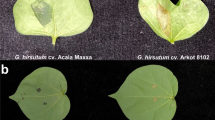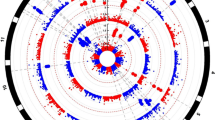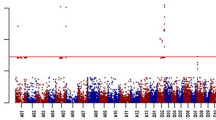Abstract
Bacterial blight (BB, caused by Xanthomonas citri pv. malvacearum, Xcm) is a worldwide disease of cotton (Gossypium spp.). The disease has been effectively controlled through the use of BB resistant cultivars and planting of acid-delinted seed. However, a resurgence of BB has been noted in the US in recent years due to the spread of Xcm race 18 and growing of susceptible transgenic cultivars, which calls for a renewed effort to develop new BB resistant cultivars. However, there has been a paucity of information in genetics and breeding for BB resistance since the 1990s due to the lack of research efforts. This review was prepared to fill this void with an objective to provide detailed results from past qualitative and quantitative genetic studies on BB resistance, including genetic designs and specific germplasm used for conducting research. More than 20 major resistance B genes (B1 to B8, B9K, B9L, B10K, B10L, B11, B12, BIn, Bn, Bs, and more than 4 unnamed genes), with at least two polygene complexes (BSm and BDm), have been identified. One B gene may be resistant to a single or multiple Xcm races, and pyramiding of several B genes can enhance resistance to a single or multiple Xcm races. Allelic relationships among some of the genes are currently unknown. Quantitative genetics has been employed to estimate heritability, gene effects, additive and dominance variances, and effective number of genes for BB resistance. The studies suggest that the additive effect and additive variance play a predominant role in BB resistance, while the dominant effect and variance play a reduced role in resistance. Heritability estimates are moderate to high depending on environmental errors, and 1–2 effective numbers of genes have been estimated, consistent with Mendelian genetic studies. Studies in molecular mapping of several BB resistance genes (B2, B3, b6, and B12) have been conducted with the focus on B12 as it is resistant to races 1 through 19. Portable DNA markers have been developed and used in marker-assisted selection for BB resistance. Finally, areas where there is a lack of information and controversies are identified and assessed. This review provides an updated comprehensive account of the genetic basis for BB resistance in cotton.
Similar content being viewed by others
References
Ajene I, Shenge KC, Akpa AD (2014) Races of Xanthomonas citri subsp. malvacearum, the causal organism of bacterial blight of cotton in northern Nigeria. Arch Phytopathol Plant Prot 47:2263–2269
Akello B, Hillocks RJ (2002) Distribution and races of Xanthomonas axonopodis pv. malvacearum on cotton (Gossypium hirsutum) in Uganda. J Phytopathol 150:65–69
Allen SJ, West KD (1991) Predominance of race 18 of Xanthomonas campestris pv. malvacearum on cotton in Australia. Plant Dis 75:43–44
Amudha J, Balasubramani G, Meshram MK, Gotmare V, Mayee CD (2003) Molecular characterization of gene introgression for bacterial blight resistance in cotton. Plant Cell Biotechnol Mol Biol 4:131–136
Bachelier B, Hequet E, Ousmane E (1992) Study of a diallel cross for resistance to bacterial blight (Xanthomonas campestris pv. malvacearum (Smith) Dow.) in cotton (Gossypium hirsutum L.). Coton Fibres Tropic 47:173–182
Bird LS (1960) Developing cotton immune to bacterial blight. In: Proceedings of cotton improv conference 12, National Cotton Council, Memphis, TN, pp 16–23
Bird LS (1966) Report of the bacterial blight committee (Xanthomonas malvacearum). In: Proceedings of the beltwide cotton production research conferences, Memphis, Tenn, Jan 11–12, 1966, pp 14–21
Bird LS (1972) Interrelationhips of resistance and escapes from multi-disease and other adversities. In: Proceedings of the beltwide cotton production research conferences, National Cotton Council, Memphis, TN, pp 92–97
Bird LS (1976) Registration of Tamcot SP21, Tamcot SP23 and Tamcot SP37 cottons. Crop Sci 16:884
Bird LS (1979a) Registration of Tamcot CAME-E cotton. Crop Sci 19:411–412
Bird LS (1979b) Registration of Tamcot CAMD-E Cotton (Reg. No. 74). Crop Sci 29:411
Bird LS (1982) The MAR (multi-adversity resistance) system for genetic improvement of cotton. Plant Dis 66:172–176
Bird LS (1986) Half a century of dynamics and control of cotton diseases: bacterial blight. Proc Beltwide Cotton Res Conf Cotton Dis Counc 46:24–33
Bird LS, Blank LM (1951) Breeding strains of cotton resistant to bacterial blight. Bull Texas Agric Exp Stn 736:25
Bird LS, Hadley HH (1959) A statistical study of the inheritance of Stoneville 20 resistance to the bacterial blight disease of cotton in the presence of Xanthomonas malvacearum races 1 and 2. Genetics 43:750–767
Blank LM (1949) Breeding for resistance to bacterial blight of cotton. Phytopathology 39:494–495
Brinkerhoff LA (1970) Variation in Xanthomonas malvacearum and its relation to control. Ann Rev Phytopathol 8:85–110
Brinkerhoff LA, Hunter RE (1961) Frequency of cotton plants resistant to Fusarium wilt in some lines of cotton resistant or susceptible to bacterial blight. Plant Dis Rep 45:126–127
Brinkerhoff LA, Verhalen LM, Mamaghani R, Johnson WM (1979) Inheritance of an induced mutation for bacterial blight resistance in cotton. Crop Sci 19:901–903
Brinkerhoff LA, Verhalen LM, Johnson WM, Essenberg M, Richardson PE (1984) Development of immunity to bacterial blight of cotton and its implications for other diseases. Plant Dis 68:168–173
Cauquil J, Follin JC (1970) Study of the effect of certain morphological or genetic characters on the behaviour of cotton towards boll rots. I. Resistance to bacterial blight. Coton Fibres Trop 25:375–385
De Sousa BW, Silveira da Cunha RW, Suassuna ND, Coutinho WM (2016) Prevalence of race 18 of Xanthomonas citri subsp. malvacearum on cotton in Brazil. Trop Plant Pathol 41:128–131
Elassbli H, Abdelraheem A, Sanogo S, Kuraparthy V, Stelly DM, Hinze L, Wheeler TA, Wedegaertner T, Zhang JF (2019) A genome-wide association study of resistance to Fusarium wilt and bacterial blight in US Upland cotton germplasm. In: Proceedings of beltwide cotton conference, pp 16–20
El-Zik KM, Bird LS (1967) Inheritance of resistance to races of Xanthomonas malvacearum (E. F. Sm.) Dowson in cotton. In: Proceedings of beltwide cotton production research conference, pp 216–217
EL-Zik KM, Bird LS (1970) Effectiveness of specific genes and gene combinations in conferring resistance to races of Xanthomonas malvacearum in Upland cotton. Phytopathology 60:441–447
ElZik KM, Thaxton PM (1996) Registration of ‘Tamcot Sphinx’ cotton. Crop Sci 36:1074
El-Zik KM, Thaxton PM (1997) Registration of seven multi-adversity resistant (MAR-5) germplasm lines of Upland cotton. Crop Sci 37:1394
Endrizzi JE, Turcotte EL, Kohel RJ (1985) Genetics, cytology and evolution of Gossypium. Adv Genet 23:271–375
Essenberg M, Bayles MB, Samad RA, Hall JA, Brinkerhoff LA, Verhalen LM (2002) Four near-isogenic lines of cotton with different genes for bacterial blight resistance. Phytopathology 92:1323–1328
Essenberg M, Bayles MB, Pierce ML, Verhalen LM (2014) Pyramiding B genes in cotton achieves broader but not always higher resistance to bacterial blight. Phytopathology 104:1088–1097
Faustine C, Hoffmann LV, Lukonge E, Tibazarwa FI (2015) Marker-assisted screening of cotton cultivars for bacterial blight resistance gene. Huria J Open Univ Tanzan 19:1–7
Follin JC, Girardot B, Mangano V, Benitez R (1988) New results on inheritance of immunity to bacterial blight (Xanthomonas campestris pv. malvacearum (Smith) Dye, race 18 and 20) in the cotton plant (Gossypium hirsutum L.). Coton Fibres Trop 43:167–175
Green JM, Brinkerhoff LA (1956) Inheritance of three genes for bacterial blight resistance in Upland cotton. Agron J 48:481–485
Harland SC (1932) The genetics of Gossypium. Bibliogr Genet 9:167
Hillocks RJ (1992) Bacterial blight. In: Hillocks RJ (ed) Cotton disease. CAB International, Wallingford, pp 39–85
Hussain T (1984) Prevalence and distribution of Xanthomonas campestris pv. malvacearum races in Pakistan and their reaction to different cotton lines. Trop Pest Manag 30:159–162
Innes NL (1961) Breeding bacterial blight resistant cotton in the Sudan by combining greenhouse inoculation with field spraying. Empire Cotton Grow Rev 38:92–100
Innes NL (1962) Bacterial blight of cotton. Leaf infection of Sakel carrying the gene B6. Empire Cotton Grow Rev 39:191–196
Innes NL (1963a) Resistance to bacterial blight of cotton in Albar. Nature 200:387–388
Innes NL (1963b) Bacterial blight of cotton: resistance conferred by the gene combination B2B3 in the Sudan. Empire Cotton Grow Rev 40:117–119
Innes NL (1964) Resistance conferred by new gene combinations to bacterial blight of cotton. Euphytica 13:33–43
Innes NL (1965a) Inheritance of resistance to bacterial blight of cotton. I. Allen (Gossypium hirsutum) derivatives. J Agric Sci 64:257–271
Innes NL (1965b) Resistance to bacterial blight of Cotton: the genes B9 and B10. Exp Agric 1:189–191
Innes NL (1965c) Inheritance of resistance to bacterial blight of cotton. II. Intra-herbaceum crosses. J Agric Sci 64:433–437
Innes NL (1965d) Sakel strains of cotton highly resistant to bacterial blight. Euphytica 14:135–138
Innes NL (1966) Inheritance of resistance to bacterial blight of cotton. III. Herbaceum resistance transferred to tetraploid cotton. J Agric Sci 66:433–439
Innes NL (1969) Inheritance of resistance to bacterial blight of cotton. IV. Tanzania selections. J Agric Sci 72:41–51
Innes NL (1974) Resistance to bacterial blight of cotton varieties homozygous for combinations of B resistance genes. Ann Appl Biol 78:89–98
Innes NL (1983) Bacterial blight of cotton. Biol Rev 58:157–176
Innes NL, Brown SJ (1969) A quantitative study of the inheritance of resistance to bacterial blight in Upland cotton. J Agric Sci 73:15–23
Innes NL, Brown SJ, Walker T (1974) Genetical and environmental variation for resistance to bacterial blight of Upland cotton. Heredity 32:53–72
Kirkby KA, Lonergan PA, Allen SJ (2013) Three decades of cotton disease surveys in NSW, Australia. Crop Pasture Sci 64:774–779
Knight RL (1944) The genetics of blackarm resistance. IV. G. punctatum (Sch. and Thon.) crosses. J Genet 46:1–27
Knight RL (1947) The genetics of blackarm resistance. V. Dwarf-bunched and its relationship to B1. J Genet 48:43–50
Knight RL (1948) The genetics of blackarm resistance. VII. Gossypium arboreum L. J Genet 49:109–116
Knight RL (1950) The genetics of blackarm resistance. VIII. Gossypium barbadense. J Genet 50:67–76
Knight RL (1953a) The genetics of blackarm resistance. IX. The gene B6m from G. arboreum. J Genet 51:270–275
Knight RL (1953b) The genetics of blackarm resistance. X. The gene B7 from Stoneville 20. J Genet 51:515–519
Knight RL (1954) The genetics of blackarm resistance. XI. Gossypium anomalum. J Genet 52:466–472
Knight RL (1957) Blackarm disease of cotton and its control. In: Proceedings of the 2nd international conference plant protection conference, Fernhurst Res St, Butterworths, London, pp 53–59
Knight RL (1963) The genetics of blackarm resistance. XII. Transference of resistance from Gossypium herbaceum to G. barbadense. J Genet 58:328–346
Knight RL, Clouston TW (1939) The genetics of blackarm resistance. I. Factors B1 and B2. J Genet 38:133–159
Knight RL, Clouston TW (1941) The genetics of blackarm resistance II. Classification, on their resistance, of cotton types and strains III. Inheritance in crosses within the Gossypium hirsutum group. J Genet 41:391–409
Knight RL, Hutchinson JB (1950) The evolution of blackarm resistance in cotton. J Genet 50:36–58
Kumar KSA, Aiyanathan KEA, Nakkeeran S, Manickam S (2018) Documentation of virulence and races of Xanthomonas citri pv. malvacearum in India and its correlation with genetic diversity revealed by repetitive elements (REP, ERIC, and BOX) and ISSR markers. Biotech 8:479
Lagiere R (1960) La bactériose du cotonnier (Xanthomonas malvacearum) (E.F. Smith) Dowson dans le monde et en République Centrafricaine (Oubangui-Chari), Paris, ICRT, p 252
Luckett DJ (1989) Diallel analysis of yield components, fibre quality and bacterial blight resistance using spaced plants of cotton. Euphytica 44:11–21
Mahill JF, Davis DD (1978) Influence of male sterile and normal cytoplasms on the expression of bacterial blight in cotton hybrids. Crop Sci 18:440–444
Mahill JF, Jenkins JN, Meredith WR Jr, Meyer VG (1979) Influence of five Gossypium species cytoplasms on the expression of bacterial blight resistance. Agron Abstr p 67. Madison. American Society of Agronomy
Marangoni M, Girotto L, Nunes MP, Almeida WP, Galbieri R, Schuster I, Mehta YR (2013) Search for a microsatellite marker linked with resistance gene to Xanthomonas axonopodis pv. malvacearum in Brazilian cotton. Am J Plant Sci 4:2039–2042
Owen DF (1967) A genetic study of bacterial blight resistance in five lines of American Upland cotton. Diss Abs 28:24
Phillips AZ, Berry JC, Wilson MC, Vijayaraghavan A, Burke J, Imani Bunn J, Allen TW, Wheeler T, Bart RS (2017) Genomics-enabled analysis of the emergent disease cotton bacterial blight. PLoS Genet 13(9):1–23
Ruano O, Mohan S (1982) Nova raça de Xanthomonas campestris pv. malvacearum (Smith) Dye no estado do Paraná. Fitopathol Bras 7:439–442
Rungis D, Llewellyn D, Dennis ES, Lyon BR (2002) Investigation of the chromosomal location of the bacterial blight resistance gene present in an Australian cotton (Gossypium hirsutum L.) cultivar. Aust J Agric Res 53:551–560
Saeedi Madani A, Marefat A, Behboudi K, Ghasemi A (2010) Phenotypic and genetic characteristics of Xanthomonas citri subsp. malvacearum, causal agent of cotton blight and identification of races in Iran. Aust Plant Path 39:440–445
Sajjad H, Khan IA, Shahid M, Muhammad A (2003) Linkage studies between bacterial blight and cotton leaf curl virus disease resistance genes in cotton. Sarhad J Agric 19:359–363
Sajjad H, Khan IA, Shahid M, Yusuf Z (2007) Inheritance studies of bacterial blight disease resistance genes in cotton (Gossypium hirsutum L.). Pak J Bot 39:603–608
Saunders JH, Innes NL (1963) The genetics of bacterial blight resistance in cotton. Further evidence on the gene B6m. Genet Res 4:382–388
Shelke GV, Aurangabadkar LP, Kashikar AR, Wadyalkar SR, Phalak MS, Kharkar HH, Umalkar GV (2012) Identification of resistance source for bacterial blight disease caused by Xanthomonas axonopodis pv. malvacearum and its genetic inheritance in Upland cotton. Cotton Res J 6:167–173
Silva RA, Barroso PAV, Hoffmann LV, Giband M, Coutinho WM (2014) A SSR marker linked to the b12 gene that confers resistance to race 18 of Xanthomonas axonopodis pv. malvacearum in cotton is also associated with other bacterial blight resistance gene complexes. Aust Plant Pathol 43:89–91
Simpson DM, Weindling R (1946) Bacterial blight resistance in a strain of Stoneville Cotton. J Am Soc Agron 38:630–635
Singh TH, Chopra BL, Randhawa LS (1987) Genetics of resistance to bacterial blight in Upland cotton. In: 1st symposium on crop improvement, 23–27 Feb 1987, Crop Improv Soc India, Ludhiana, India, p 103
Singh LP, Chabra BS, Seth S, Singh DP (1989) Graphical analysis in Upland cotton in F2 generation. J Indian Soc Cotton Improv 14:100–101
Thaxton PM, El-Zik KM (2004) Registration of 'Tamcot Pyramid' cotton. Crop Sci 44:343
Thaxton PM, Brooks TD, El-Zik KM (2001) Race identification and severity of bacterial blight from natural infestations across the cotton belt. In: Proceedings of beltwide cotton conference, Anaheim, CA 9–13 Jan 2001. National Cotton Council America, Memphis, TN, pp 137–138
Thyssen GN, Jenkins JN, McCarty JC, Zeng L, Campbell BT, Delhom CD, Islam MS, Li P, Jones DC, Condon BD, Fang DD (2019) Whole genome sequencing of a MAGIC population identified genomic loci and candidate genes for major fiber quality traits in Upland cotton (Gossypium hirsutum L.). Theor Appl Genet 132:989–999
Verma JP (1986) Bacterial blight of cotton. CRC Press Inc, Boca Raton
Wallace TP, El-Zik KM (1989) Inheritance of resistance in three cotton cultivars to the HVI isolate of bacterial blight. Crop Sci 29:1114–1119
Wallace TP, El-Zik KM (1990) Quantitative analysis of resistance in cotton to three new isolates of the bacterial blight pathogen. Theor Appl Genet 79:443–448
Wendel JF (1989) New World tetraploid cottons contain Old World cytoplasm. Proc Natl Acad Sci (USA) 86:4132–4136
Wheeler TA (2018) Bacterial blight on cotton. In: Beltwide cotton conference, San Antonio, TX Jan 3–5, 2018, pp 11–18
Wheeler TA (2020) Report of the bacterial blight committee for the 2019 year. In: 2020 beltwide cotton conference, Austin, TX Jan 8–10, 2020 (in press)
Wheeler TA, Gannaway JR (1998) Effect of cotton pathogens on disease symptoms and yield of cotton varieties in large plot field trials. In: Proceedings of beltwide cotton conference, San Diego, CA 5–9 Jan, 1998, National Cotton Council, Memphis, TN, pp 165–169
Wheeler TA, Woodward JE, Kelley M (2016) Response of cotton cultivars to 2015 bacterial blight causing isolates in field and greenhouse trials. In: Beltwide cotton conferences, New Orleans, LA, Jan 5–7, 2016. National Cotton Council, Memphis, TN, pp 798–805
Wright RJ, Thaxton PM, El-Zik KM, Paterson AH (1998) D subgenome bias of Xcm resistance genes in tetraploid Gossypium (cotton) suggests that polyploidy formation has created novel avenues for evolution. Genetics 149:1987–1996
Xiao JH, Fang DD, Bhatti M, Hendrix B, Cantrell RG (2010) A SNP haplotype associated with a gene resistant to Xanthomonas axonopodis pv. malvacearum in Upland cotton (Gossypium hirsutum L.). Mol Breed 25:593–602
Yang Z, Nguyen B, Wright R (2015) Physical mapping B12 resistance in the cotton. Plant Cell Biotechnol Mol Biol 16:1–11
Zachowski A, Rudolph K (1988) Characterization of isolates of bacterial blight of cotton (Xanthomonas campestris pv. malvacearum) from Nicaragua. J Phytopathol 123:344–352
Zhang JF, Zhu Y, Abdelraheem A, Teng ZH, Thyssen GN, Fang DD, Jenkins JN, McCarty J, Wedegaertner T (2019) A genome-wide association study of Fusarium wilt resistance in a magic population of Upland cotton. In: Proceedings of beltwide cotton conference, National Cotton Council, Memphis, TN, p 14
Zhang JF, Abdelraheem A, Thyssen GN, Fang DD, Jenkins JN, McCarty JC Jr, Wedegaertner T (2020) Evaluation and genome-wide association study of Verticillium wilt resistance in a MAGIC population derived from intermating of eleven Upland cotton (Gossypium hirsutum) parents. Euphytica 216:9
Author information
Authors and Affiliations
Corresponding author
Additional information
Publisher's Note
Springer Nature remains neutral with regard to jurisdictional claims in published maps and institutional affiliations.
Rights and permissions
About this article
Cite this article
Zhang, J., Bourland, F., Wheeler, T. et al. Bacterial blight resistance in cotton: genetic basis and molecular mapping. Euphytica 216, 111 (2020). https://doi.org/10.1007/s10681-020-02630-w
Received:
Accepted:
Published:
DOI: https://doi.org/10.1007/s10681-020-02630-w




